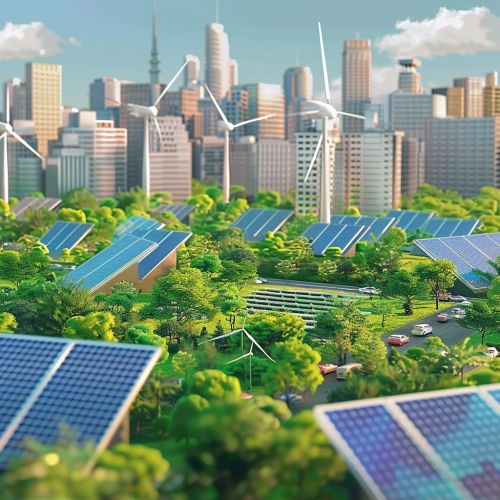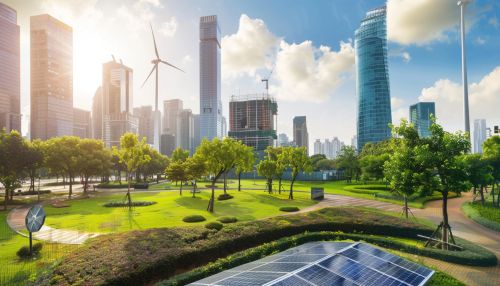Sustainable city
Introduction
A sustainable city, also known as an eco-city, is a metropolitan area designed with consideration of environmental impact, inhabited by people dedicated to minimization of required inputs of energy, water, and food, and waste output of heat, air pollution - CO2, methane, and water pollution. Cities can be immensely efficient. They can also be major contributors to climate change if they are not designed and governed with sustainability in mind.
History and Development
The concept of a sustainable city is rooted in the broader concept of sustainable development. The term was first coined in the 1980s, in response to a growing realization of the need to balance economic and social progress with concern for the environment and the stewardiness of natural resources. Since then, the idea of a sustainable city has evolved to encompass a wide range of environmental, social, and economic objectives.


Key Principles
A sustainable city incorporates principles of sustainable development into its policies and practices. These principles include:
Efficiency
Efficiency in the use of resources and energy is a key principle of a sustainable city. This can be achieved through a variety of means, including the use of renewable energy sources, energy-efficient buildings, and efficient transportation systems.
Resilience
Resilience, or the ability to withstand and recover from shocks and stresses, is another key principle. This can be achieved through measures such as climate change adaptation, disaster risk reduction, and the creation of resilient infrastructure and communities.
Equity
Equity, or fairness in the distribution of benefits and burdens, is a third key principle. This can be achieved through measures such as inclusive decision-making, equitable access to services and resources, and the promotion of social cohesion and inclusivity.
Strategies for Sustainability
There are many strategies that cities can employ to become more sustainable. These include:
Urban Planning
Urban planning plays a crucial role in creating sustainable cities. This involves designing cities in a way that promotes efficiency and reduces environmental impact. This can be achieved through measures such as compact urban form, mixed-use development, and the creation of green spaces.
Green Infrastructure
Green infrastructure, such as parks, green roofs, and rain gardens, can help to reduce environmental impact and improve quality of life. These features can provide a range of benefits, including stormwater management, air quality improvement, and urban heat island mitigation.
Sustainable Transportation
Sustainable transportation systems, such as public transit, cycling infrastructure, and pedestrian-friendly streets, can reduce greenhouse gas emissions and improve air quality. They can also promote physical activity and improve quality of life.
Waste Management
Sustainable waste management practices, such as recycling and composting, can reduce the amount of waste that goes to landfill and reduce greenhouse gas emissions. They can also create jobs and economic opportunities.
Case Studies
There are many cities around the world that are leading the way in sustainability. These include:
Copenhagen, Denmark
Copenhagen, Denmark, is often cited as one of the world's most sustainable cities. The city has a long-term goal to be carbon-neutral by 2025, and has implemented a range of measures to achieve this, including a district heating system powered by renewable energy, a comprehensive cycling infrastructure, and a commitment to green building.
Curitiba, Brazil
Curitiba, Brazil, is another leading example of a sustainable city. The city has a comprehensive bus rapid transit system, which serves as a model for other cities around the world. It also has a range of innovative social programs, including a program that exchanges recyclables for bus tickets.
Vancouver, Canada
Vancouver, Canada, is also a leader in sustainability. The city has a goal to be the greenest city in the world by 2020, and has implemented a range of measures to achieve this, including a green building code, a comprehensive cycling and pedestrian network, and a food scraps recycling program.
Challenges and Opportunities
While there are many opportunities for cities to become more sustainable, there are also many challenges. These include:
Technological Challenges
Technological challenges include the need for new technologies to reduce greenhouse gas emissions, improve energy efficiency, and manage waste. While many of these technologies exist, they are often expensive and not widely adopted.
Economic Challenges
Economic challenges include the need for funding to implement sustainability measures, and the need to create economic incentives for sustainability. This can be a particular challenge in developing countries, where resources are often scarce.
Social Challenges
Social challenges include the need to engage citizens in sustainability efforts, and the need to ensure that sustainability measures are equitable and inclusive. This can be a challenge in cities with high levels of inequality and social exclusion.
Despite these challenges, there are also many opportunities for cities to become more sustainable. These include the potential for sustainability measures to create jobs and economic opportunities, the potential for new technologies to improve quality of life, and the potential for cities to lead the way in addressing global challenges such as climate change and resource scarcity.
